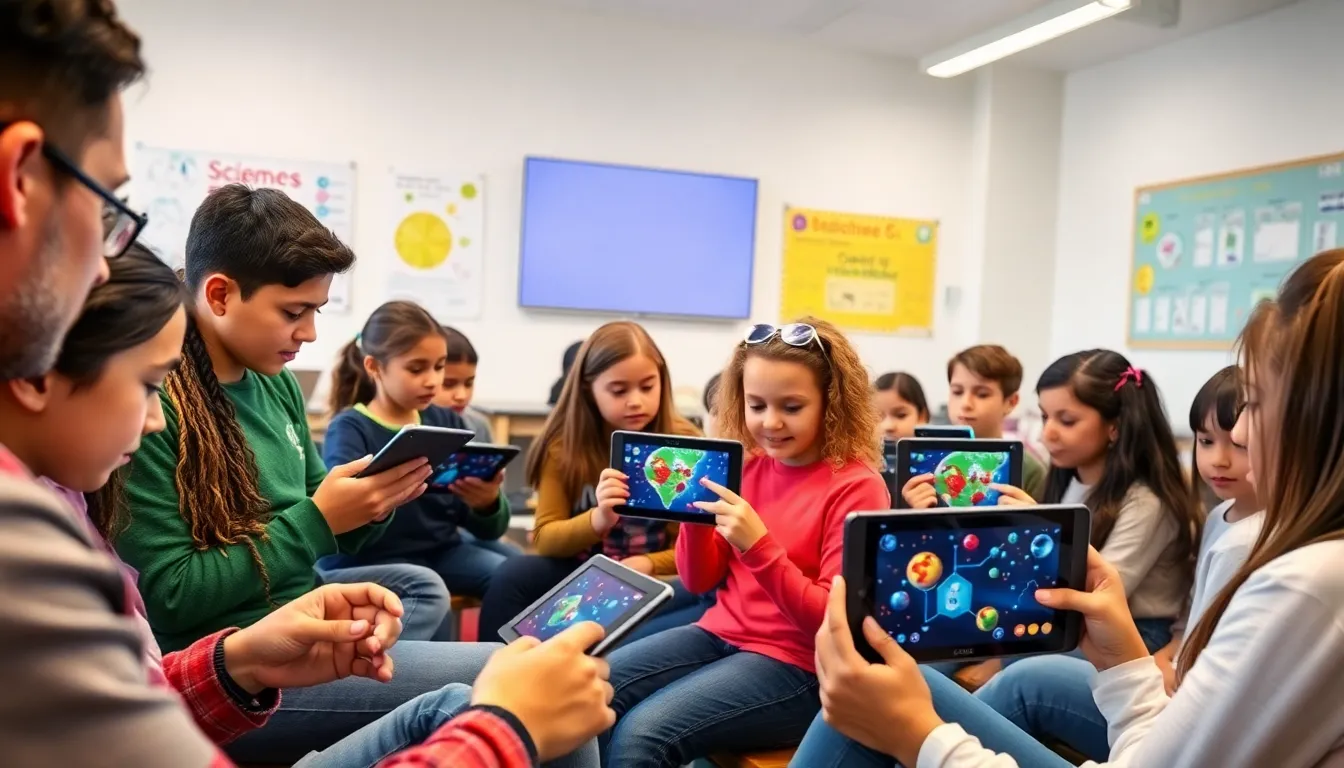Table of Contents
ToggleIn a world where knowledge is just a tap away, learning the basics of science doesn’t have to feel like pulling teeth. Forget the dusty textbooks and boring lectures. With the right apps, anyone can dive into the wonders of science while having a blast. Imagine mastering the laws of physics or exploring the mysteries of biology—all from the comfort of your couch, in your pajamas.
These apps turn complex concepts into bite-sized pieces that are easy to digest. Whether you’re a curious kid or an adult looking to brush up on your science smarts, there’s something for everyone. So grab your smartphone and get ready to explore the universe, one app at a time. Who knew learning could be this much fun?
Overview of Science Learning Apps
Science learning apps enhance the educational experience by making complex topics more digestible. Various applications cater to different age groups and learning styles, providing interactive content. Engaging strategies like quizzes, animations, and simulations help users grasp fundamentals effectively.
Some apps focus on specific fields such as biology, chemistry, or physics, while others offer a broad overview of multiple disciplines. Accessibility is a key feature; users can access resources anytime, anywhere through their smartphones or tablets. Popular examples include Khan Academy, which covers an extensive range of subjects through videos and exercises, and Labster, which simulates laboratory experiences for practical understanding.
Additionally, many apps provide progress tracking, allowing learners to monitor their improvement over time. Gamified elements engage users further, turning learning goals into fun challenges. Quizlet and Flipgrid stand out for their user-generated content, enabling learners to create study materials and engage in collaborative learning.
Classroom integration has become seamless with apps that support teachers in administering lessons or assignments. Students often enjoy a heightened interest in science when utilizing these digital tools, as they relate to real-world applications. Regular updates keep content fresh and aligned with current scientific developments.
A wide variety of science learning apps exist, each catering to specific needs and preferences. He or she can choose apps based on personal learning objectives, ensuring an engaging and effective study experience.
Key Features to Look For

Selecting the right science learning app involves identifying key features that enhance the educational experience. Users benefit from a range of functionalities that facilitate understanding and engagement.
User-friendly Interface
A user-friendly interface encourages engagement and retention. Intuitive navigation allows learners to explore topics without frustration. Clarity in design enhances the learning experience, ensuring users of all ages can interact with content easily. Visual aids and responsive layouts support comprehension. Simple layouts eliminate distractions, allowing focus on essential material. Access to quick tutorials or help sections provides assistance as needed.
Interactive Content
Interactive content significantly enhances learning retention. Gamified quizzes present challenges that motivate users to engage actively. Simulations and animations bring concepts to life, making complex topics more relatable. Varied types of content appeal to different learning styles, accommodating visual, auditory, and kinesthetic learners. Feedback mechanisms allow users to assess their knowledge and track progress effectively. Engaging activities foster curiosity, leading to a deeper understanding of scientific principles.
Top Apps to Learn Science Basics
Science learning apps make education accessible and enjoyable. They simplify complex concepts and help users engage with scientific topics effectively.
App 1: Khan Academy
Khan Academy offers a vast library of science content, covering subjects like biology, chemistry, and physics. Users can access thousands of instructional videos, practice exercises, and quizzes. The platform also features personalized learning dashboards, enabling individuals to track their progress. Its user-friendly interface promotes easy navigation. With its effective teaching strategies, Khan Academy caters to various learning styles, making it suitable for all ages.
App 2: Labster
Labster provides immersive simulated lab experiences, allowing students to conduct virtual experiments. It focuses on key scientific concepts, engaging learners with realistic animations and interactive labs. This app aligns with curriculum standards and enhances understanding of complex topics. Users can revisit specific sections as needed, reinforcing knowledge retention. Labster’s gamified approach keeps learning engaging while preparing students for real-world scenarios.
App 3: Quizlet
Quizlet enhances the study experience through customizable flashcards and quizzes. Users create and share content, promoting collaborative learning. The app supports various study modes, including matching games and practice tests. It also tracks progress, allowing users to see improvements over time. Quizlet’s versatility makes it an excellent choice for those seeking to reinforce their understanding of scientific concepts through interactive and engaging methods.
User Reviews and Ratings
User feedback highlights the effectiveness of various science learning apps. Many users appreciate the intuitive interfaces that promote seamless navigation. Khan Academy, for instance, receives praise for its extensive library of instructional videos, making complex topics easier to grasp. Labster stands out due to its immersive simulations, enabling learners to experience virtual lab environments.
Ratings often reflect the engaging content these apps provide. Quizlet’s flashcards and quizzes are frequently mentioned as useful tools that enhance retention. Users report significant improvements in their understanding of scientific concepts after using gamified features. Flipgrid’s collaborative approach in promoting user-generated content draws favorable reviews as students advocate for shared learning experiences.
Accessibility ranks among the top reasons why users prefer these apps. Students can learn on-the-go, fitting education into their busy schedules. Feedback mechanisms also garner positive remarks; users find that receiving timely assessments helps track their progress effectively. Various age groups, from young learners to adults, express contentment with the diverse material available.
In terms of ratings, many apps achieve high scores on major platforms. Users often rate Khan Academy and Labster above four stars, indicating strong satisfaction. This consistent feedback underscores the demand for effective science learning tools. As learners continue to seek interactive methods for education, reviews suggest that these apps solidify their place in the modern learning landscape.
Overall, the collective user reviews and ratings highlight the transformative impact of these apps on science education, offering a blend of engagement, accessibility, and effectiveness.
Benefits of Using Apps for Science Learning
Apps for science learning provide numerous advantages that enhance the educational experience. Enhanced accessibility stands out, allowing users to explore scientific concepts anytime and anywhere. Users can access a wealth of resources on smartphones or tablets, benefiting from portable education solutions.
Engagement levels increase with interactive content. Quizzes, animations, and simulations draw users into learning environments that captivate attention. Gamified learning features create fun challenges, helping individuals stay motivated while mastering complex topics.
Diverse content caters to various age groups and learning styles. Some applications focus solely on specific subjects like biology or chemistry, while others cover broad scientific fields. This variety makes it easy to find suitable materials tailored to different learning preferences.
Progress tracking features enable users to monitor their learning journeys. Immediate feedback and assessment tools demonstrate understanding, allowing learners to identify areas needing improvement. Collaborative learning becomes possible with platforms encouraging user-generated content, fostering connections among peers.
App integration in classroom settings offers teachers effective lesson planning tools. Educators can streamline administrative tasks, allowing more time for student engagement. Various apps support learning objectives, enhancing curriculum delivery in diverse educational environments.
User satisfaction reflects the effectiveness of these tools. Many learners have achieved significant improvements in scientific understanding through popular apps like Khan Academy and Labster. High ratings and positive reviews highlight the intuitive interfaces and robust content that define these applications. Overall, science learning apps transform education by making it accessible, engaging, and efficient.
Embracing science learning apps can transform the educational experience for learners of all ages. With their interactive content and user-friendly interfaces, these apps make complex topics accessible and engaging. They not only promote self-paced learning but also foster collaboration among peers, enhancing understanding through shared experiences.
As technology continues to advance, the potential for these apps to revolutionize science education grows. By taking advantage of the tools available, learners can explore scientific concepts in innovative ways that fit their individual needs. Whether through gamified quizzes or immersive simulations, science learning apps are paving the way for a more dynamic and enjoyable educational journey.








